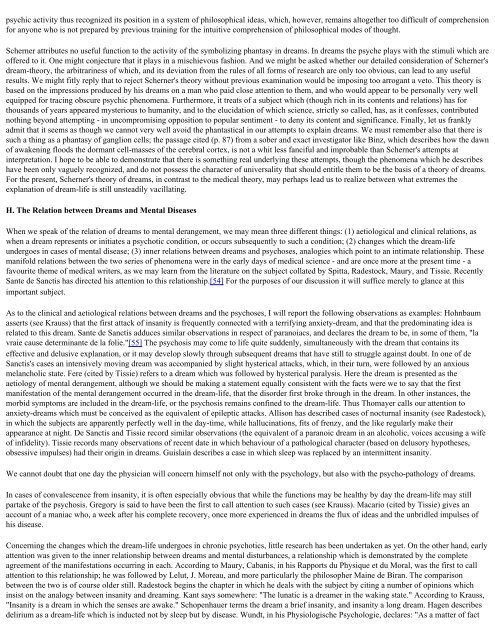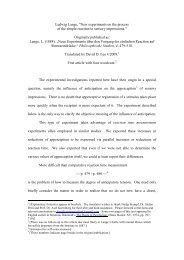The Interpretation Of Dreams Sigmund Freud (1900) PREFACE
The Interpretation Of Dreams Sigmund Freud (1900) PREFACE
The Interpretation Of Dreams Sigmund Freud (1900) PREFACE
Create successful ePaper yourself
Turn your PDF publications into a flip-book with our unique Google optimized e-Paper software.
psychic activity thus recognized its position in a system of philosophical ideas, which, however, remains altogether too difficult of comprehension<br />
for anyone who is not prepared by previous training for the intuitive comprehension of philosophical modes of thought.<br />
Scherner attributes no useful function to the activity of the symbolizing phantasy in dreams. In dreams the psyche plays with the stimuli which are<br />
offered to it. One might conjecture that it plays in a mischievous fashion. And we might be asked whether our detailed consideration of Scherner's<br />
dream-theory, the arbitrariness of which, and its deviation from the rules of all forms of research are only too obvious, can lead to any useful<br />
results. We might fitly reply that to reject Scherner's theory without previous examination would be imposing too arrogant a veto. This theory is<br />
based on the impressions produced by his dreams on a man who paid close attention to them, and who would appear to be personally very well<br />
equipped for tracing obscure psychic phenomena. Furthermore, it treats of a subject which (though rich in its contents and relations) has for<br />
thousands of years appeared mysterious to humanity, and to the elucidation of which science, strictly so called, has, as it confesses, contributed<br />
nothing beyond attempting - in uncompromising opposition to popular sentiment - to deny its content and significance. Finally, let us frankly<br />
admit that it seems as though we cannot very well avoid the phantastical in our attempts to explain dreams. We must remember also that there is<br />
such a thing as a phantasy of ganglion cells; the passage cited (p. 87) from a sober and exact investigator like Binz, which describes how the dawn<br />
of awakening floods the dormant cell-masses of the cerebral cortex, is not a whit less fanciful and improbable than Scherner's attempts at<br />
interpretation. I hope to be able to demonstrate that there is something real underlying these attempts, though the phenomena which he describes<br />
have been only vaguely recognized, and do not possess the character of universality that should entitle them to be the basis of a theory of dreams.<br />
For the present, Scherner's theory of dreams, in contrast to the medical theory, may perhaps lead us to realize between what extremes the<br />
explanation of dream-life is still unsteadily vacillating.<br />
H. <strong>The</strong> Relation between <strong>Dreams</strong> and Mental Diseases<br />
When we speak of the relation of dreams to mental derangement, we may mean three different things: (1) aetiological and clinical relations, as<br />
when a dream represents or initiates a psychotic condition, or occurs subsequently to such a condition; (2) changes which the dream-life<br />
undergoes in cases of mental disease; (3) inner relations between dreams and psychoses, analogies which point to an intimate relationship. <strong>The</strong>se<br />
manifold relations between the two series of phenomena were in the early days of medical science - and are once more at the present time - a<br />
favourite theme of medical writers, as we may learn from the literature on the subject collated by Spitta, Radestock, Maury, and Tissie. Recently<br />
Sante de Sanctis has directed his attention to this relationship.[54] For the purposes of our discussion it will suffice merely to glance at this<br />
important subject.<br />
As to the clinical and aetiological relations between dreams and the psychoses, I will report the following observations as examples: Hohnbaum<br />
asserts (see Krauss) that the first attack of insanity is frequently connected with a terrifying anxiety-dream, and that the predominating idea is<br />
related to this dream. Sante de Sanctis adduces similar observations in respect of paranoiacs, and declares the dream to be, in some of them, "la<br />
vraie cause determinante de la folie."[55] <strong>The</strong> psychosis may come to life quite suddenly, simultaneously with the dream that contains its<br />
effective and delusive explanation, or it may develop slowly through subsequent dreams that have still to struggle against doubt. In one of de<br />
Sanctis's cases an intensively moving dream was accompanied by slight hysterical attacks, which, in their turn, were followed by an anxious<br />
melancholic state. Fere (cited by Tissie) refers to a dream which was followed by hysterical paralysis. Here the dream is presented as the<br />
aetiology of mental derangement, although we should be making a statement equally consistent with the facts were we to say that the first<br />
manifestation of the mental derangement occurred in the dream-life, that the disorder first broke through in the dream. In other instances, the<br />
morbid symptoms are included in the dream-life, or the psychosis remains confined to the dream-life. Thus Thomayer calls our attention to<br />
anxiety-dreams which must be conceived as the equivalent of epileptic attacks. Allison has described cases of nocturnal insanity (see Radestock),<br />
in which the subjects are apparently perfectly well in the day-time, while hallucinations, fits of frenzy, and the like regularly make their<br />
appearance at night. De Sanctis and Tissie record similar observations (the equivalent of a paranoic dream in an alcoholic, voices accusing a wife<br />
of infidelity). Tissie records many observations of recent date in which behaviour of a pathological character (based on delusory hypotheses,<br />
obsessive impulses) had their origin in dreams. Guislain describes a case in which sleep was replaced by an intermittent insanity.<br />
We cannot doubt that one day the physician will concern himself not only with the psychology, but also with the psycho-pathology of dreams.<br />
In cases of convalescence from insanity, it is often especially obvious that while the functions may be healthy by day the dream-life may still<br />
partake of the psychosis. Gregory is said to have been the first to call attention to such cases (see Krauss). Macario (cited by Tissie) gives an<br />
account of a maniac who, a week after his complete recovery, once more experienced in dreams the flux of ideas and the unbridled impulses of<br />
his disease.<br />
Concerning the changes which the dream-life undergoes in chronic psychotics, little research has been undertaken as yet. On the other hand, early<br />
attention was given to the inner relationship between dreams and mental disturbances, a relationship which is demonstrated by the complete<br />
agreement of the manifestations occurring in each. According to Maury, Cabanis, in his Rapports du Physique et du Moral, was the first to call<br />
attention to this relationship; he was followed by Lelut, J. Moreau, and more particularly the philosopher Maine de Biran. <strong>The</strong> comparison<br />
between the two is of course older still. Radestock begins the chapter in which he deals with the subject by citing a number of opinions which<br />
insist on the analogy between insanity and dreaming. Kant says somewhere: "<strong>The</strong> lunatic is a dreamer in the waking state." According to Krauss,<br />
"Insanity is a dream in which the senses are awake." Schopenhauer terms the dream a brief insanity, and insanity a long dream. Hagen describes<br />
delirium as a dream-life which is inducted not by sleep but by disease. Wundt, in his Physiologische Psychologie, declares: "As a matter of fact



